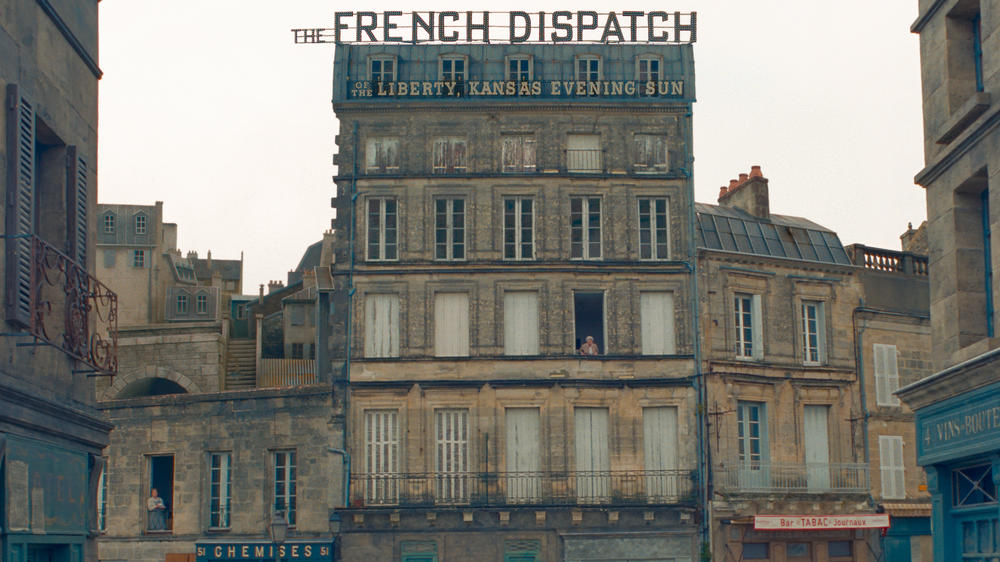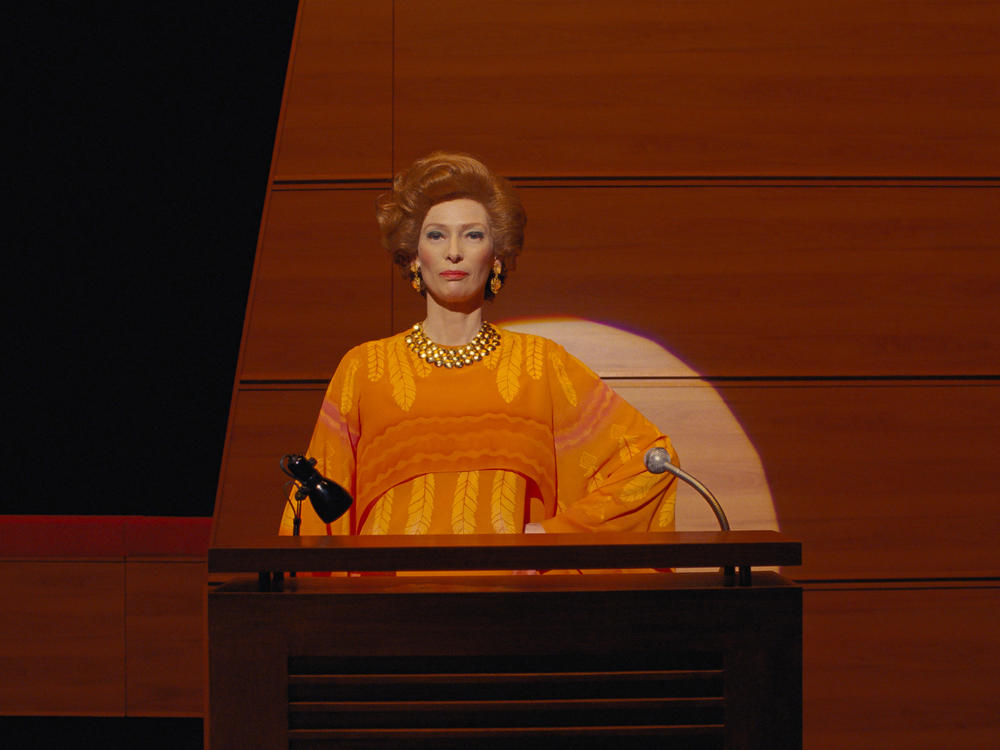Section Branding
Header Content
'The French Dispatch' is a love letter to 'The New Yorker' — and to love itself
Primary Content
The French Dispatch is Wes Anderson's tenth feature film.
This means, even before the lights go down in the theater, you know two things about it already, and for certain:
Thing One: It will be meticulously, painstakingly constructed. A rigorous attention to detail and an exacting eye for a highly defined personal aesthetic will come baked into its every frame, from the set design to the cinematography to its color palette(s) to its dialogue to its performances. Also,
Thing Two: It's never gonna let you forget about Thing One. Anderson's films are all about artifice, about the theater of it all. He wants us to remain fully aware that we are watching his movies, to make us complicit in the act of observing. Know, for example, that The French Dispatch contains a sequence that shifts to animation to dramatize a high-speed chase, and another that transforms one character's memory into a literal theatrical production. The film employs several freeze-framed tableaux of crowd scenes for us to admire, and as Anderson's camera pans sloooowly across them, he wants us to notice that he's not employing a photographic technique — he's simply asked his actors to hold stock-still, unblinking. (They mostly do.)
He massages his dialogue into a near-musical cadence. His actors adopt his signature affectless, deadpan style of delivery.
It's why Anderson has proven so divisive a filmmaker. Those of us who enjoy his work use words like stylized, idiosyncratic, and imaginative.
If you don't like it, you employ a different set of descriptors entirely: Mannered. Self-indulgent. Twee.
Eye-candy is still candy, after all
Let's agree: Anderson's films are a pleasure to watch, in the moment. All that fastidiousness, all that assiduously symmetrical framing, all the sheer, cinematographic sweat-equity he puts into his movies for our enjoyment — not to mention the appearance of his go-to cadre of actors like Bill Murray, Owen Wilson, Edward Norton and Tilda Swinton — can't help but leave you grinning from ear-to-ear as you gaze up at the screen.
Or more precisely: While you're gazing up at the screen.
But what happens once once the film's over and the lights go up? Will that highly specific feeling of pleasure stick with you? Or was all that eye-candy just so much sugar floss that dissolves in the lightest rain? That's the real question before us.
The classic knock on Wes Anderson is that his fondness for extreme stylization too easily overwhelms the story — and the senses. If he doesn't bother to connect his signature, fussily cinematic vision to anything resembling human emotion, it quickly devolves into nothing more than a posture — simple archness, mere satire, an exquisite but empty shell, a Rube Goldberg dollhouse.
Whenever we viewers sense that a filmmaker's devoted more thought to how to compose a given shot than what's at stake within it, we tend to get worried. If you don't care about your characters, we think, why should you expect us to? You're so focused on the window dressing, you've forgotten that you're supposed to be selling us the dang clothes.
This is likely why those Anderson movies driven by directly relatable emotional states of being like familial sadness (The Royal Tenenbaums), adolescent alienation (Rushmore) or romantic longing (The Grand Budapest Hotel) find wider, more devoted audiences than films like The Life Aquatic or The Darjeeling Limited, in which the filmmaker's baseline misanthropy is allowed to drive the action.
Happily, The French Dispatch proves itself to be an act of devotion — both to a specific kind of writing, and to human attachment itself.
L'amour toujour, in triplicate
The French Dispatch is, as you have likely heard by now, a love letter to The New Yorker — specifically writers like Mavis Gallant, A.J. Liebling, James Baldwin, Lucy Sante and Joseph Mitchell. It is presented as a series of individual stories appearing in the final issue of a magazine – a Sunday supplement to a fictional newspaper in Liberty, Kansas. The magazine, edited by a curmudgeonly editor (Bill Murray) inspired by New Yorker editors Harold Ross and William Shawn, is headquartered in the equally fictional French city of Ennui-sur-Blasé. (Hold for the grunt of performatively knowing amusement from the dude sitting in front of you in the theater.)
The magazine's writers gather stories on the streets of this city, the first of which is about a brilliant painter who's criminally insane, the second about a student revolt, while the third documents a kidnapping of the son of the town's police commissioner — and how the official chef of the police department (note: not chief as in head of, but chef as in de cuisine) figures into it.
In this way, the film comprises three very different, but equally idiosyncratic, love stories — one between an artist and his muse, one between a young revolutionary and an older journalist, and another between father and son. All feature performances that ground even the most fanciful events in the real.
In the first tale, an art critic (a strikingly-wigged Tilda Swinton) lectures about the life and work of Benicio del Toro's tortured artist, who spends most of his life in prison for murder. Léa Seydoux is the female guard who inspires his paintings, and Adrien Brody an art dealer seeking to cash in. There's some light satiric ribbing of the Art World and its opportunistic acquisitiveness, but scenes between del Toro and Seydoux are allowed to generate the heat they need to — though, Anderson being Anderson, said heat radiates fitfully outward, at oblique angles, and through a scrim.
In the second vignette, Frances McDormand channels Mavis Gallant as a writer observing an uprising among university students led by a passionate wastrel (Timothée Chalamet) and his much-more-on-the-ball girlfriend (Lyna Khoudri). On the surface, Anderson lampoons the rhetoric of revolution and the motivations of its proponents, but the real subject is McDormand's journalistic objectivity, and how easily it crumbles in the face of Chalamet's ... uh, face. His cheekbones, in particular.
Getting it just Wright
The third and most effective story features Jeffrey Wright as a writer inspired by James Baldwin, recounting how he found himself dragged along as the local police commissioner (Mathieu Amalric) sets out to rescue his son (Winsen Ait Hellal) from kidnappers led by a dastardly chauffer (Edward Norton).
Jeffrey Wright isn't among the stable of actors Anderson has used before, but his work in The French Dispatch makes a strong case that he should be, going forward. Wright adopts Anderson's house style, nailing those familiar, signature rhythms in his delivery, but he also manages to convey a deep sense of melancholy, a loneliness; he creates a man who channels his aching need for connection into his writing. As a result, Wright's performance reaches out of the screen, providing the emotional hook than any Anderson film desperately needs, if it's to linger in the memory.
Like all films made by Wes Anderson, The French Dispatch comes packed with lots and lots of delightful bells and whistles — but it's the much simpler, steadier sound of Wright's sad, soft voice that manages to rise above it all, and stays with you as you leave the theater.
Copyright 2021 NPR. To see more, visit https://www.npr.org.


